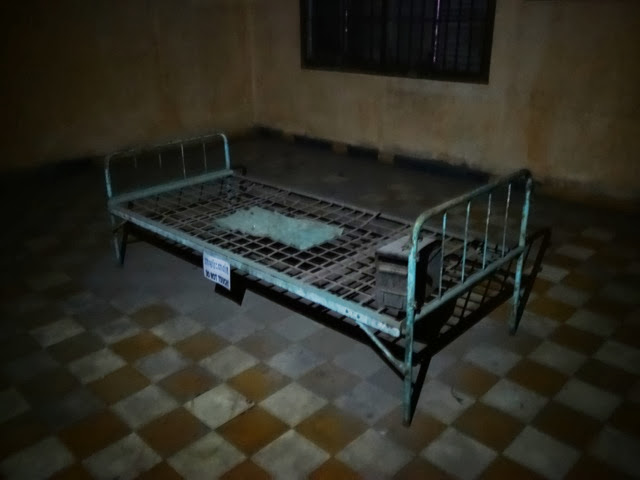Pol Pot and his Khmer Rouge marched into Phnom Penh on 17th April 1975 and immediately set about dismantling every aspect of society, dissolving jobs, separating families, removing all rights to any property, outlawing religion and doing everything necessary to return the state to 'Year Zero'. The distinction was made between the 'Old People' peasants and farmers who toiled in the country (good) and 'New People' - educated city dwellers (bad). The new people - doctors, lawyers, teachers, journalists, Buddhists, any kind of dissenter, foreigners, and the families of all of the above, were incarcerated, tortured into fabricating any kind of confession and then executed, but not before giving the names of colleagues and family members who would soon face similar treatment. City dwellers that escaped immediate death were forcibly exiled to the countryside and compelled to work the land, despite having neither skills nor tools, in an insane attempt to triple national rice production within a year. The result was famine. That was the first year or two. After that the regime began to turn on itself. Dissent was in the ranks and Pol Pot, Brother no. 1 became increasingly paranoid, and many members of his party and their families also found themselves bundled away in the night to a torture centre and then on to a mass grave.
The Choeung Ek Genocidal Centre is a memorial and education site that has been built around one of these mass graves. Known as the Killing Fields, there are at least two hundred known mass graves around the country, but this is the one closest to Phnom Penh and the one that draws all the tourists. It's reckoned that 20,000 people were executed here. They were brought at night in covered trucks from the nearby S21 prison blind-fold and bound; and admidst the noise of a generator and revolutionary songs played loud over the tannoy, were forced to kneel at the freshly dug pit, and as their names were checked off a carefully maintained list, were bludgeoned into it with a spade, or hoe or an iron axl from a cart.
Executioners were reported to have laughed as they killed children, so as not to be seen to be sympathising with their victims.
At least two million people out of a population of eight were killed between 1975 and 1979 when the regime was finally ousted. Pol Pot continued as leader of the exiled Khmer Rouge for another twenty years and never faced justice. Incredibly even after 1979, it was the Khmer Rouge that had seats in the UN, rather than the new government imposed by Vietnam.
It begs the question, how could a people turn on their own kin in such a savage and prolonged manner? There was no war being fought here in '75 to justify the radical expropriation of land, possessions, society, rights and morality. The Milgram experiments show that an individual can act with terrible cruelty when authority is imposed and responsibility ceded, but this ideological experiment, coming a decade after Mao's disastrous Great Leap Forward, and imposed by the most cruel, divisive and insidious means really beggars belief. "To keep you is no gain, to destroy you is no loss".
The Cheung Ek centre is a deeply moving place. The calm and measured first-hand accounts on the headphone audio-tour helps visitors remain quiet, contemplative and respectful.
From there, like the drivers of the now empty trucks, I travelled back into the city to the S21 prison. By the time I arrived it was dark and I was the only visitor to this former school. It was turned by the KR from a place of teaching, to a place of unknowable torment. I can think of no more horrific place. The photographic mugshots of the victims, taken upon arrival line the walls, and look down on the iron bed frames where they were manacled, and the devices which were used upon them. Some of the former classrooms in the three storey building have been roughly divided into brick cells, others remain open. Upstairs there are copies of long confessions, mostly Cambodian, but also a few foreigners, including an unfortunate Australian who strayed into Cambodian territorial waters at the wrong time. Being a foreigner gained you no protection at all.
I exited the building's barbed wire and concrete by moonlight, psyche barely intact. I spoke to my tuk-tuk driver. Two years younger than me, he'd lost both his parents and his older brother to these atrocities.






No comments:
Post a Comment
Note: only a member of this blog may post a comment.